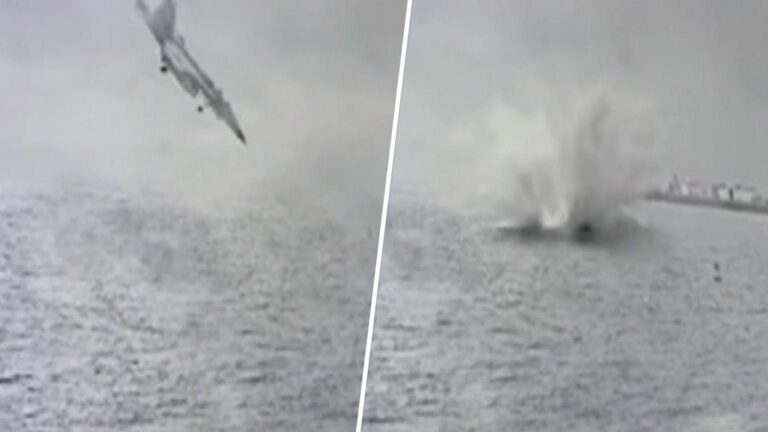Navy Fighter Jet Accident in San Diego Harbor During Training Exercise
Early Tuesday morning, a U.S. Navy fighter jet unexpectedly plunged into San Diego Harbor amid a routine training mission, causing alarm among local residents. Thankfully, the two crew members aboard successfully ejected and were quickly rescued by emergency teams, sustaining no serious injuries. The Navy has initiated a thorough investigation to uncover the root cause of the mishap. Meanwhile, harbor authorities imposed temporary restrictions on boat traffic to facilitate rescue operations and secure the crash zone.
Preliminary information indicates the aircraft experienced technical issues shortly after takeoff, compelling the pilot to initiate an emergency ejection over the water. Coordinated efforts by the Coast Guard, Navy divers, and local emergency responders focused on securing the site and recovering vital parts of the jet. Key immediate actions included:
- Swift crew rescue: Both aviators were safely retrieved within minutes post-ejection.
- Harbor access control: Vessel movement was limited to ensure operational safety.
- Crash site preservation: The area was cordoned off for detailed forensic examination.
| Detail | Information |
|---|---|
| Aircraft Model | F/A-18 Hornet |
| Incident Location | San Diego Harbor |
| Time of Event | Early Morning Hours |
| Crew Status | Safe, No Reported Injuries |
| Investigation Status | Active and Ongoing |
Crew Ejection and Emergency Response Efforts
The pilot and weapons systems officer demonstrated exemplary professionalism and quick thinking by ejecting just seconds before the jet submerged in the harbor waters. Rescue teams promptly located the parachuting airmen, confirming their stable condition with only minor injuries reported. Eyewitnesses described seeing the parachutes deploy clearly, highlighting the effectiveness of the emergency protocols in place.
Emergency crews immediately secured the crash vicinity to mitigate environmental hazards and protect public safety. Measures included:
- Containment of potential fuel spills and hazardous substances
- Collaboration between naval units and local agencies for site management
- Continuous water quality monitoring to detect contamination
- Systematic debris removal to restore harbor conditions
Ongoing Investigation into Jet Malfunction
Following the unexpected crash, Navy investigators have launched a comprehensive inquiry to determine the factors that led to the aircraft’s failure. The crew’s emergency ejection was executed according to established safety protocols, ensuring their survival. Specialists from the Navy’s aviation safety division are meticulously examining the wreckage, including cockpit instruments and engine components, to gather critical evidence.
The investigation is focusing on several key areas:
- Mechanical integrity: Evaluating engine performance and flight control systems for faults.
- Human factors: Analyzing pilot communications, decision-making, and response timing.
- Environmental conditions: Reviewing weather data and visibility at the time of the incident.
The Navy has pledged to maintain transparency by providing regular updates as new information emerges, aiming to enhance future flight safety and prevent recurrence.
| Investigation Component | Current Status | Responsible Entity |
|---|---|---|
| Engine and Systems Analysis | In Progress | Aviation Maintenance Unit |
| Pilot Debriefing | Planned | Naval Safety Office |
| Meteorological Review | Ongoing | Naval Weather Service |
Recommendations for Strengthening Naval Aviation Safety
In light of the recent San Diego Harbor crash, defense safety analysts advocate for enhanced safety measures and more rigorous pilot training programs to reduce the likelihood of similar incidents. Proposed improvements include advanced simulation exercises that replicate emergency scenarios, stricter pre-flight inspections, and refined ejection protocols to boost pilot survivability during critical events. These initiatives aim to uphold mission readiness while prioritizing aviator safety under high-pressure conditions.
Highlighted safety enhancement strategies:
- Deployment of cutting-edge flight simulators replicating complex emergency situations
- Mandatory recurrent training emphasizing rapid decision-making and crisis response
- Upgraded maintenance checks to identify and address aircraft vulnerabilities early
- Improved communication channels between flight crews and command centers
| Proposed Measure | Anticipated Benefit |
|---|---|
| Enhanced Simulator Training | Faster and more effective pilot reactions during emergencies |
| Routine Safety Audits | Early detection of mechanical issues |
| Emergency Procedure Drills | Increased success rates of safe ejections |
| Upgraded Communication Systems | Minimized miscommunication during critical flight phases |
Summary and Next Steps
The investigation into the Navy jet’s crash in San Diego Harbor remains active, with officials dedicated to uncovering the precise causes behind the incident. All crew members have been confirmed safe and are undergoing medical evaluations. The Navy continues to collaborate closely with local authorities to monitor and mitigate any environmental impact, ensuring the safety of the surrounding community. Updates will be shared as the inquiry progresses and new findings become available.







